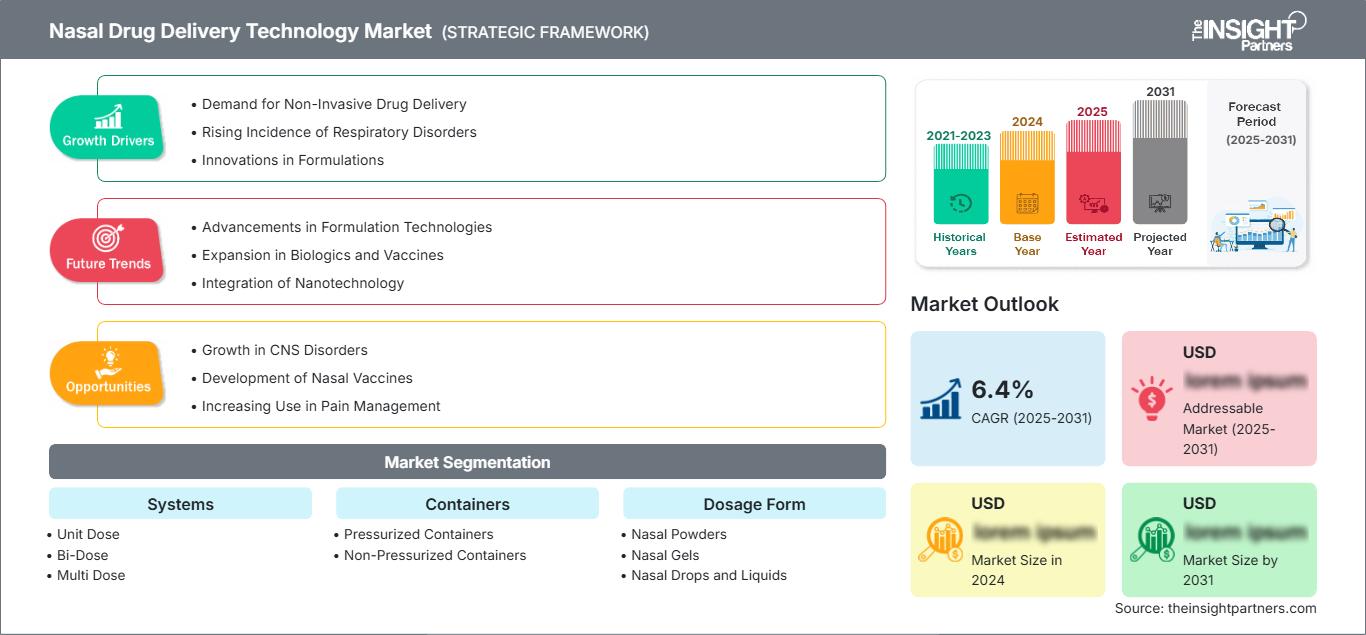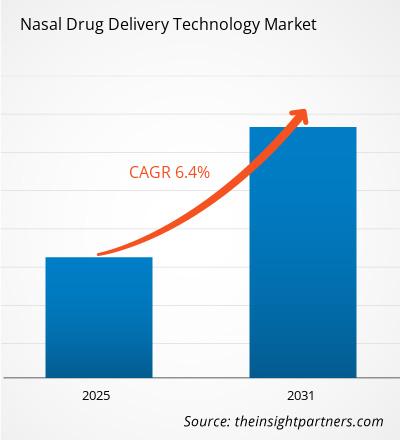Si prevede che il mercato della tecnologia per la somministrazione nasale di farmaci raggiungerà i 125,51 miliardi di dollari entro il 2031. Si prevede che il mercato registrerà un CAGR del 6,8% nel periodo 2025-2031.
Il rapporto sul mercato della tecnologia per la somministrazione nasale di farmaci comprende l'analisi per sistemi (dose unitaria, bi-dose, multidose); contenitori (contenitori pressurizzati, contenitori non pressurizzati); forma di dosaggio (polveri nasali, gel nasali, gocce e liquidi nasali, spray nasale, altri); applicazione terapeutica (rinite allergica e non allergica, congestione nasale, vaccinazioni, altre applicazioni); utente finale (ospedali, assistenza domiciliare) e area geografica (Nord America, Europa, Asia-Pacifico e Sud e Centro America). L'analisi globale è ulteriormente suddivisa a livello regionale e per i principali paesi. Il rapporto offre il valore in USD per l'analisi e i segmenti sopra indicati.
Scopo del rapporto
Il rapporto "Nasal Drug Delivery Technology Market" di The Insight Partners mira a descrivere il panorama attuale e la crescita futura, i principali fattori trainanti, le sfide e le opportunità. Ciò fornirà spunti a vari stakeholder aziendali, come:
- Fornitori/produttori di tecnologia: per comprendere le dinamiche di mercato in evoluzione e conoscere le potenziali opportunità di crescita, consentendo loro di prendere decisioni strategiche informate.
- Investitori: per condurre un'analisi completa delle tendenze in merito al tasso di crescita del mercato, alle proiezioni finanziarie di mercato e alle opportunità esistenti lungo la catena del valore.
- Organismi di regolamentazione: per regolamentare le politiche e le attività di controllo sul mercato con l'obiettivo di ridurre al minimo gli abusi, preservare la fiducia degli investitori e sostenere l'integrità e la stabilità del mercato.
Sistemi di segmentazione del mercato della tecnologia di somministrazione di farmaci nasali
- Dose unitaria
- Bi-dose
- Multidose
Contenitori
- Contenitori pressurizzati
- Contenitori non pressurizzati
Forma di dosaggio
- Polveri nasali
- Gel nasali
- Gocce e liquidi nasali
- Spray nasale
- Altri
Applicazione terapeutica
- Rinite allergica e non allergica
- Congestione nasale
- Vaccinazioni
- Altre applicazioni
Utente finale
- Ospedali
- Assistenza sanitaria domiciliare
Potrai personalizzare gratuitamente qualsiasi rapporto, comprese parti di questo rapporto, o analisi a livello di paese, pacchetto dati Excel, oltre a usufruire di grandi offerte e sconti per start-up e università
Mercato della tecnologia di somministrazione nasale dei farmaci: Approfondimenti strategici

-
Ottieni le principali tendenze chiave del mercato di questo rapporto.Questo campione GRATUITO includerà l'analisi dei dati, che vanno dalle tendenze di mercato alle stime e alle previsioni.
Fattori di crescita del mercato della tecnologia di somministrazione nasale dei farmaci
- Domanda di somministrazione non invasiva dei farmaci: la dimensione del mercato della somministrazione nasale è determinata dalla sua praticità ed efficacia, come evidenziato dalle analisi di mercato. L'analisi competitiva mostra una crescente adozione per la gestione del dolore.
- Crescente incidenza di disturbi respiratori: le tendenze di mercato ne descrivono l'utilizzo nel trattamento dell'asma e delle allergie, stimolando così il mercato globale.
- Innovazioni nelle formulazioni: i report di mercato indicano un'innovazione nelle formulazioni dei farmaci in termini di biodisponibilità, che porta a una differenziazione competitiva.
Tendenze future del mercato della tecnologia di somministrazione nasale dei farmaci
- Progressi nelle tecnologie di formulazione: lo sviluppo di nuove formulazioni, inclusi bio-potenziatori e sistemi mucoadesivi, sta aumentando l'efficienza e la stabilità della somministrazione nasale dei farmaci.
- Espansione di farmaci biologici e vaccini: la somministrazione nasale sta guadagnando popolarità per farmaci biologici e vaccini, con l'aumento della ricerca e dello sviluppo di formulazioni di vaccini nasali, inclusi quelli per l'influenza e il COVID-19.
- Integrazione della nanotecnologia: la nanotecnologia viene integrata nei sistemi di somministrazione nasale dei farmaci per migliorare l'assorbimento del farmaco, la somministrazione mirata e il rilascio controllato.
Opportunità di mercato della tecnologia di somministrazione nasale dei farmaci
- Crescita nei disturbi del SNC: la somministrazione nasale dei farmaci è un metodo promettente per il trattamento dei disturbi del sistema nervoso centrale (SNC), come il morbo di Alzheimer, il morbo di Parkinson e l'epilessia, offrendo un rapido assorbimento del farmaco e un accesso diretto al cervello.
- Sviluppo di vaccini nasali: i vaccini nasali rappresentano un'enorme opportunità, soprattutto sulla scia della pandemia di COVID-19, poiché consentono una somministrazione senza ago e sono più facili da distribuire.
- Crescente utilizzo nella gestione del dolore: esiste l'opportunità di sviluppare sistemi di somministrazione nasale per la gestione del dolore, ad esempio per il rapido sollievo dall'emicrania o dal dolore oncologico acuto.
Mercato della tecnologia di somministrazione nasale dei farmaci
Le tendenze regionali e i fattori che influenzano il mercato delle tecnologie per la somministrazione nasale di farmaci durante il periodo di previsione sono stati ampiamente spiegati dagli analisti di The Insight Partners. Questa sezione illustra anche i segmenti di mercato e la geografia della gestione delle malattie del ritmo cardiaco in Nord America, Europa, Asia-Pacifico, Medio Oriente e Africa, America meridionale e centrale.
Ambito del rapporto di mercato sulla tecnologia di somministrazione di farmaci per via nasale
| Attributo del rapporto | Dettagli |
|---|---|
| Dimensioni del mercato in 2024 | US$ XX Billion |
| Dimensioni del mercato per 2031 | US$ 125.51 Billion |
| CAGR globale (2025 - 2031) | 6.8% |
| Dati storici | 2021-2023 |
| Periodo di previsione | 2025-2031 |
| Segmenti coperti |
By Sistemi
|
| Regioni e paesi coperti |
Nord America
|
| Leader di mercato e profili aziendali chiave |
|
Densità degli operatori del mercato della tecnologia di somministrazione nasale dei farmaci: comprendere il suo impatto sulle dinamiche aziendali
Il mercato delle tecnologie per la somministrazione nasale di farmaci è in rapida crescita, trainato dalla crescente domanda degli utenti finali, dovuta a fattori quali l'evoluzione delle preferenze dei consumatori, i progressi tecnologici e una maggiore consapevolezza dei benefici del prodotto. Con l'aumento della domanda, le aziende stanno ampliando la propria offerta, innovando per soddisfare le esigenze dei consumatori e sfruttando le tendenze emergenti, alimentando ulteriormente la crescita del mercato.

- Ottieni il Mercato della tecnologia di somministrazione nasale dei farmaci Panoramica dei principali attori chiave
Punti di forza
- Copertura completa: il rapporto analizza in modo esaustivo prodotti, servizi, tipologie e utenti finali del mercato delle tecnologie per la somministrazione nasale di farmaci, offrendo una panoramica olistica.
- Analisi degli esperti: il rapporto è redatto sulla base della conoscenza approfondita di esperti e analisti del settore.
- Informazioni aggiornate: il rapporto garantisce la pertinenza aziendale grazie alla copertura di informazioni e dati recenti.
- Opzioni di personalizzazione: questo rapporto può essere personalizzato per soddisfare le esigenze specifiche del cliente e adattarsi in modo appropriato alle strategie aziendali.
Il rapporto di ricerca sul mercato delle tecnologie per la somministrazione nasale di farmaci può quindi contribuire a guidare il percorso di decodificazione e comprensione dello scenario del settore e delle prospettive di crescita. Sebbene possano esserci alcune valide preoccupazioni, i vantaggi complessivi di questo rapporto tendono a superare gli svantaggi.
- Analisi storica (2 anni), anno base, previsione (7 anni) con CAGR
- Analisi PEST e SWOT
- Valore/volume delle dimensioni del mercato - Globale, Regionale, Nazionale
- Industria e panorama competitivo
- Set di dati Excel
Report recenti
Rapporti correlati
Testimonianze
Motivo dell'acquisto
- Processo decisionale informato
- Comprensione delle dinamiche di mercato
- Analisi competitiva
- Analisi dei clienti
- Previsioni di mercato
- Mitigazione del rischio
- Pianificazione strategica
- Giustificazione degli investimenti
- Identificazione dei mercati emergenti
- Miglioramento delle strategie di marketing
- Aumento dell'efficienza operativa
- Allineamento alle tendenze normative






















 Ottieni un campione gratuito per - Mercato della tecnologia di somministrazione nasale dei farmaci
Ottieni un campione gratuito per - Mercato della tecnologia di somministrazione nasale dei farmaci